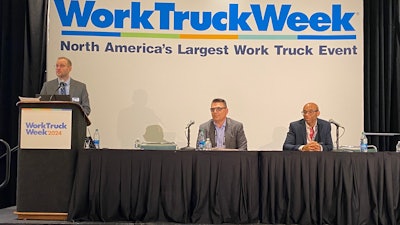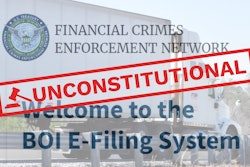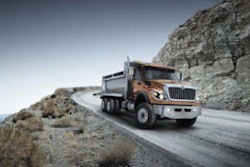
California’s vehicle regulations are complicated. That’s not news to anyone.
But Wednesday at the Work Truck Show in Indianapolis, NTEA’s Andrew Wrobel and panelists with experience dealing with California Air Resources Board (CARB) regulations did their best to clarify what the state’s new commercial trucking rules actually require of customers, and how OEMs, dealers and upfitters can support their customers in complying with regulations.
Among the two highest visibility regulations introduced by CARB this year, Wrobel said the Advanced Clean Fleets rule is the more challenging of the two.
Wrobel said one reason for that is because the industry still doesn’t know who is impacted. California’s Trucking Association (CTA) sued CARB last October, claiming state regulators did not have the authority to instruct private fleets on what equipment they integrate into their fleets. The Environmental Protection Agency (EPA) has yet to comment on the suit, but if it sides on behalf of CARB, state regulators will enforce the regulation retroactively to Jan. 1, 2024.
[RELATED: DTNA's Aufdemberg says trucking's green future will require partnerships, multiple technologies]
Wrobel said that uncertainty has created a tough purchasing environment for California truck buyers. Public fleets must comply with the regulations and have already started integrating zero-emission vehicles (ZEVs) into their operations. But for everyone else? Wrobel said carriers who would be impacted by ACF have been forced to decide if they want to comply now, or wait and hope the EPA sides on their behalf.
 Information from California's Air Resources Board (CARB) on the fleets impacted by the state's Advanced Clean Fleets regulation.
Information from California's Air Resources Board (CARB) on the fleets impacted by the state's Advanced Clean Fleets regulation.
And ACF’s impact is far reaching. If the regulation receives EPA’s approval, it will apply to fleets with more than 50 vehicles in their nationwide population or more than $50 million in annual revenue, operating Class 2b-8 trucks, off-road yard trucks and light-duty specialty vehicles, as well as smaller fleets who may have common ownership or control with a larger entity (such as a small pickup-and-delivery operation exclusive to FedEx, Wrobel said).
“If you have more than 50 trucks and five are operating in California, those five need to follow the ACF rule,” Wrobel said.
Fleets also can comply with ACF in two ways — either by purchasing only ZEVs moving forward, or choosing to sunset existing ICE vehicles when they reach the end of the state-defined useful life period, and backfilling their fleet with ZEVs as needed.
[RELATED: MEMA's Pulse webinar tackles 2024 business predictions, California regulations]
Under the regulation, all impacted fleets would be required to operate 100% ZEVs by 2042.
Gregory Skinner, vice president, strategic insights, Escalent, said his business has met with a lot of fleets that do not want to comply with the regulations and will wait until the last minute when they are required to adopt them. Skinner said he understands that school of thought but said at some point, the regulations will hit all fleets.
CARB’s Advanced Clean Trucks rule requires OEMs to sell a percentage of ZEVs moving forward, with the state intending to require only ZEV sales in 2036. Fleets domiciled in California that are not impacted by ACF will still eventually be impacted by ACT, the state’s low NOx omnibus regulations and more. Skinner said at some point trying to avoid the regulations will become as challenging as adopting them.
“It will be like waiting to do the homework assignment until the last day,” he said.
Yet Skinner and fellow panelist Rick Albertini, president and CEO, Phenix Truck & Van, also acknowledged how challenging adopting the regulations are today — especially for work truck operations that require complicated upfitting to their vehicles. Albertini said his business has experience upfitting battery electric work trucks and vans and said the process requires a complete overhaul of conventional upfitting practices. Albertini said some new EV producers in the market are unfamiliar with the process have developed chassis that can’t easily be upfitted. He said other, legacy manufacturers produce a vehicle that’s easier to upfit, but also mentioned because EV batteries are so heavy, storage positioning on units must be moved toward the rear to balance out vehicle weight.
“You almost design the body backward,” he said.
With no timeline set for the EPA to decide ACF’s reach, Wrobel and the panelists said the best thing upfitters and dealers can do today is educate customers about what does (and could) impact their operations in the years ahead.
Fleets that are required to comply with CARB regulations are not eligible for the state’s many grants and incentive programs, but fleets that choose to comply ahead of being mandated can receive financial support. Skinner said dealers who connect those customers with OEMs and grant programs are likely to earn customer loyalty and keep their customers from being penalized for non-compliance.
Wrobel also noted that while CARB does have a robust list of potential exemptions, fleets must apply for those exemptions and be approved to ignore any regulatory requirements.











